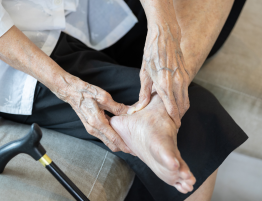
How Do Ankle Sprains Happen and How Common Are They?
Ankle sprains are one of the most common injuries, especially among athletes and active individuals. They occur when the ligaments that support the ankle stretch beyond their limits and tear. This often happens when the foot twists or rolls unexpectedly, causing the ligaments to be overstretched. Ankle sprains can happen during various activities, from playing sports to simply walking on an uneven surface.
How Do Simple Ankle Sprains Heal?
Most ankle sprains are mild and heal well with proper care. Here’s a typical healing timeline:
- First Few Days: You may experience swelling, bruising, and pain. Rest, ice, compression, and elevation (the RICE method) are crucial during this period.
- 1-2 Weeks: Swelling and bruising start to subside. Gentle movements and exercises can be introduced to maintain flexibility and strength.
- 3-6 Weeks: Most of the pain should be gone, and normal activities can be resumed gradually.
- 6+ Weeks: The ankle should be back to normal with no pain or swelling, indicating complete healing.
Signs of complete healing include the absence of pain during activities, no swelling, and restored strength and flexibility in the ankle.
Causes of Ongoing Pain After an Ankle Sprain
While many ankle sprains heal without issues, some people experience ongoing pain. This can be due to several reasons:
- Incomplete Healing: Sometimes the ligaments may not heal properly.
- Re-injury: The ankle might be reinjured before it has fully healed.
- Other Conditions: Injury to structures other than the ligaments, like the tendons around the ankle or the cartilage lining the inside of the joint.
Ankle Instability
Ankle instability occurs when the ligaments do not heal properly, leading to a weak ankle that easily gives way. This can cause recurrent sprains and a persistent feeling of the ankle being “wobbly.”
Diagnosis:
- Physical Examination: Your Foot & Ankle consultant will check for looseness of the ankle.
- Imaging Tests: On top of X-rays, MRIs may be used to assess ligament damage.
Treatment:
- Bracing: Wearing an ankle brace to provide support.
- Physiotherapy: Strengthening exercises to improve stability.
- Surgery: In severe cases, surgery may be necessary to repair or reconstruct the ligaments.
Osteochondral Ankle Lesions
Osteochondral lesions are injuries to the cartilage and underlying bone of the ankle joint. These usually occur from the initial trauma of the ankle sprain.
Diagnosis:
- Imaging Tests: MRI or CT scans can identify these lesions.
Treatment:
- Rest and Physiotherapy: Is useful in the early phase when the chance of revascularisation of the lesion is still high.
- Medications: Anti-inflammatory medication is useful again in the early phase to manage pain.
- Surgery: Depends on the age, size and location of the lesion, overall alignment, condition of the remaining part of the joint and more. Surgery is done arthroscopic or open, and usually involve removal of the unviable cartilage and bone, drilling of the bone to enhance circulation. In bigger lesions a reconstruction might be needed.
The Role of Physiotherapy and Podiatry in Treatment
Physiotherapy
Physiotherapy plays a vital role in the recovery from ankle sprains and managing ongoing pain. A physiotherapist can design a rehabilitation program tailored to your needs, focusing on:
- Strengthening Exercises: To build muscle around the ankle.
- Balance Training: To prevent future sprains.
- Manual Therapy: To improve joint mobility and reduce pain.
Podiatry and Orthotics
Podiatrists can help manage and prevent ankle issues through:
- Orthotics: Custom-made shoe inserts to provide proper foot alignment and support.
- Footwear Advice: Recommending shoes that offer better support and stability.
Proper rehabilitation and support from physiotherapists and podiatrists can significantly enhance recovery and prevent future injuries. If you experience ongoing pain after an ankle sprain, consult a specialist to ensure proper diagnosis and treatment.
Mr Hisham Shalaby
MD, FRCS Ed (Tr & Orth)
Mr H Shalaby is a specialised Foot and Ankle Consultant based in Edinburgh, Scotland and is a visiting consultant in various international centres across the Middle East. To book an appointment for a consultation click here.





